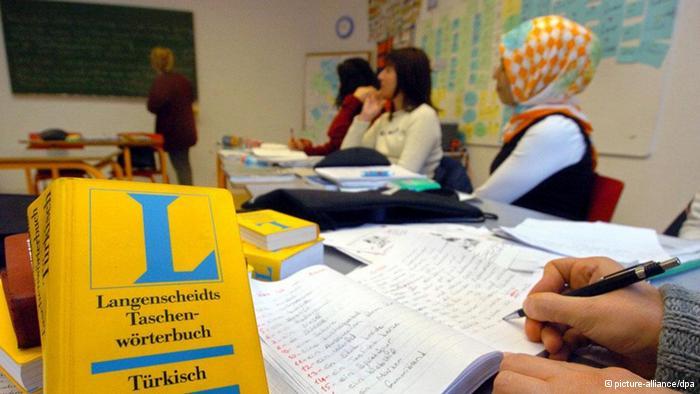কোনটি কি জেনে নিন বুঝে নিন
Students who intend to enter a university in Germany, are required to prove their German language skills by doing one of the two known tests: TestDaF and DSH.
Many students (including me) get so confused, and can’t decide on which test to have. But since I tried them both, I liked to express my experience in this article, so that it may help who is looking for an answer : TestDaF or DSH ?? which one is simpler, and which one more difficult ?
The 2 tests are similar, but they also differ in some points, which could be essential to choose between them. Let’s first discuss the structure of both tests along with the grading method: One of the major differences is that TestDaF is a standardized test, which means that whenever and wherever you do the test, you get the same test structure with different content. Where DSH has some standard rules, but in general is up to the university doing the test! Therefore, you have to search between universities offering the test, or ask people already took the test somewhere, to find a test-center with an acceptable difficulty level.
TestDaF
Grading system : TestDaF consists of 4 parts, the grade of each is over 5, so the full mark of TestDaF is 20 and what’s required by most universities is 16 or 80% in other words.
Structure in depth
- Reading comprehension: 60 minutes, consists of 3 parts:
- Part I: you have to match between 8 short paragraphs and 10 statements, each statement to which paragraph (or none) belongs.
- Part II: you read a journalistic text about a scientific subject, then you have to answer 10 multiple-choice questions.
- Part III: you read a complicated scientific text, then you have to answer 10 statements, whether each statement is true, false or doesn’t belong to the text at all.
- Listening comprehension: 40 minutes, consists of 3 parts:
- Part I: a very general and simple part, you hear it once and have to answer 8 questions in brief words.
- Part II: more complicated one, you also hear it once but have to answer 10 statements true/false mode.
- Part III: a very complicated scientific paragraph, you hear it twice and have to answer 7 questions in full sentences.
- Writing: 60 minutes, in which you have to produce a paragraph concerning a specific given topic, and in most cases it’s something about analyzing graphs.
- Speaking: about 30 minutes, consists of 7 parts about different subjects, each of which has 2-3 minutes to prepare and 0.5-2 minutes to speak, where you record your voice to a computer part after another.
DSH
DSH consists also of 4 parts, but the grade isn’t separated equally between them. You do first a written exam with the first 3 parts, then do the oral part, and the final grade is the minimum between the two grades.
Grading system : is divided into 3 levels:
- DSH-3 : 82% and above
- DSH-2 : 67-82%, and this is the minimum requirement by the universities
- DSH-1 : 57-67%, not useful but considered as “passed”
- Below 57% : failed
The DSH consists of one written and one oral exam. The written exam is made up of the following task areas:
- Comprehension and processing of a dictated text
- Guideline-oriented text production
- Comprehension and processing of a written text
- Processing linguistic structures of a scholarly-terminological nature
The examination takes approximately 4.5 hours. The individual task areas may be combined with one another.
In the oral examination, the linguistic and oral competency of the candidate is ascertained. The exam is structured like a discussion, the starting point of which is based on a thematic text from the university applicant’s field of experience.
Candidates are expected to portray the text’s facts in a coherent, adequate manner, use supportive and supplementary examples, and prove that they are in the position to question, contradict, make conjectures, etc.
The duration of the oral examination is a total of 40 minutes; the first 20 minutes are for preparations and the exam situation itself runs for the remaining 20 minutes.
As mentioned above, the structure of DSH isn’t constant but I’ll try to summarize the common points
- Writing: 60 minutes, very similar to TestDaF by analyzing graphs.
- Listening comprehension: about 60 minutes, you listen to one paragraph twice, at the first time you don’t know the questions and should take notes about everything you hear, at the second time you get the questions and should better your notes concerning the given questions, after that you have to answer different types of questions e.g. comparisons, number recognition.
- Reading comprehension and grammar: 90 minutes, you get one long paragraph and have to answer different types of questions on it, followed by 7-10 grammar questions concerning the same subject of the paragraph.
- Oral test: usually you do this part 2-3 weeks after the written one in case you got DSH-2 or -3 in it, you discuss a topic related to your field of specialization with a board consisting of 2-3 people.
TestDaF vs. DSH
| TestDaF | DSH | Recommended | |
| Standardized | Yes | No | TestDaF |
| Min required grade | 80% | 67% | DSH |
| Writing | Exactly the same | – | |
| Reading | 3 parts Cons: the 3rd one is extremely difficult Pros: bigger chance to answer, since there’re 3 different parts |
1 part Cons: if it happened that you couldn’t understand the text well, you’re in a big trouble. But mostly this doesn’t happen. Pros: different types of questions |
DSH |
| Grammar | No | Yes most students learn a lot of grammar, therefore this part is helpful to get more points |
DSH |
| Listening | 3 parts Cons: the 3rd part is extremely hard, and you have to answer in full sentences Pros: 1st part is very easy, and 2nd one is multiple choice |
1 part Cons: long test – 1st time you have to listen and take notes without knowing the questions – different types of questions, and therefore different types of concentration is required Pros: text is read by people not played from CD |
TestDaF |
| Oral | Record answers to PC Cons: it makes it harder and very strict to the subject |
Discuss with people Cons: up to the mood of the examiner Pros: more flexible |
DSH |
| Totally recommended | DSH | ||
Some Comments:
- “I’ve taken both. I took the DSH when studying abroad and took the TestDaF later, because a lot of people advised me that it is accepted by everyone, whereas the DSH is not. Supposedly. EVERY Uni I look at and every uni I applied to accepted my DSH results from Heidelberg without any issue. I think it’s much easier to get the required grade on the DSH rather than Test-DaF. The DSH grade is one grade…an “average” of all sections. It means you can actually not do well on one section and still get the DSH-2 required by most unis. The Test-DaF is different. You get a grade for each section and the unis generally require that you get a 4 on every section…so you have to be equally good in each of them. It’s not impossible or ridiculously hard though.” [Chad8504, toytowngermany.com]
- “Ich denke, dass diese Unterschiede zwischen DSH und TestDaF für euer subjektives Empfinden des Schwierigkeitsgrads der Prüfung viel entscheidender sind als alle objektiv messbaren Unterschiede. Deshalb solltet ihr diese unbedingt in eure Überlegungen einbeziehen, welche Prüfung ihr machen wollt – vorausgesetzt natürlich, dass ihr überhaupt die Wahl habt.” [Ulrich C. Mattmüller, deutschlernen-blog.de]
Youtube link:
Source: Internet, Wiki, etc.
লিখেছেন Rashidul Hasan,জানুয়ারি ২০১৩
INTERNATIONALE ZERTIFIKATE
|
Europäischer Referenzrahmen |
Elementare Sprachbeherrschung |
Selbständige Sprachbeherrschung |
Kompetente Sprachbeherrschung |
|||||||||||
|
Anfänger A1 |
Grundlegende A2 |
Fortgeschrittene B1 |
Selbständige B2 |
Fachkundige C1 |
annähernd C2 |
|||||||||
|
A1.1 |
A1.2 |
A2.1 |
A2.2 |
B1.1 |
B1.2 |
B2.1 |
B2.2 |
C1.1 |
C1.2 |
C2.1 |
C2.2 |
|||
|
British Council (IELTS) |
Basic User |
Basic User |
Band 4,0 bis 4,5 |
Band 5,0 bis 6,0 |
Band 6,5 bis 8,0 |
Band 8,5 bis 9 |
||||||||
|
Universität Cambridge*
|
Key English Test |
Preliminary English Test |
First Certificate in English (FCE), Grade C |
Certificate in Advanced English (CAE), Grade C |
Certificate of Proficiency in English (CPE), Grade C |
|||||||||
|
Institut Français |
DELF A1 |
DELF A2 |
DELF B1 |
DELF B2 |
DALF C1 |
DALF C2 |
||||||||
|
Instituto Cervantes |
Nivel Initial |
Nivel Intermedio |
Nivel Superior |
|||||||||||
|
Goethe-Institut |
Start Deutsch 1 |
Start Deutsch 2 |
B1 Zertifikat Deutsch |
Goethe-Zertifikat B2 |
Goethe-Zertifikat C1 |
Goethe-Zertifikat C2: |
||||||||
|
Test DaF |
TDN 3/ 4 |
TDN 4/5 |
||||||||||||
|
DSH* |
DSH-1 |
DSH-2 |
DSH-3 |
|||||||||||
|
UNICERT |
UNIcert Basis |
I |
II |
III |
IV |
|||||||||
|
Polnisch* |
PL-B1 |
PL-B2 |
PL-C2 |
|||||||||||
|
Niederländisch* (Universität Amsterdam und Leuven) |
PTIT |
PMT |
PPT |
PAT |
||||||||||
|
Italienisch, CILS |
A1 adulti all’estero |
A2 adulti all’estero |
Stufe 1 |
Stufe 2 |
Stufe 3 |
Stufe 4 |
||||||||
|
TOEFL iBT* |
57-86 |
87-109 |
110-120 |
/ |
||||||||||
|
TOEIC* |
Listening/Reading 550
|
Listening/Reading |
Listening/Reading |
|||||||||||
ERLÄUTERUNGEN
* Im FZHB gibt es Informationen zu den Zertifikaten und Vorbereitungskurse, aber kein eigenes Prüfungsangebot bzw. keine Kooperation mit Anbieter
Gelbe Markierung = sprachliche Studienvoraussetzung
IELTS = International English Language Testing System, über British Council in Deutschland angeboten
Test DaF = Deutsche Sprachprüfung für den Hochschulzugang ausländischer Studienbewerber; wird hochschulübergreifend anerkannt
TDN = Test Daf Niveau. TDN3 lieg tam Ende der Stufe B2 und am Anfang der Stufe C1
DSH = Deutsche Sprachprüfung für den Hochschulzugang ausländischer Studienbewerber
UNIcert = Fremdsprachenzertifikat des Arbeitskreises der Sprachenzentren an deutschen Hochschulen
CILS =Certificazione di Italiano come Lingua Straniera
TOEFL = Test of English as a Foreign Language
TOEIC=Test of English for International Communication
PAT = Profiel academische taalvaardigheid
PMT= Profiel maatschappelijke taalvaardigheid
PPT= Profiel professionele taalvaardigheid
PTIT= Profiel academische taalvaardigheid
Source: fremdsprachenzentrum-bremen.de

